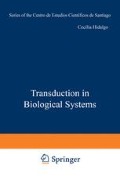Abstract
This chapter focuses on an unresolved aspect of muscle function, namely, how does sarcoplasmic reticulum (SR) release calcium ions, thereby causing muscle to contract? A schematic drawing of a small segment of a muscle cell is depicted in the upper part of Fig. 1. Two key structures in excitation-contraction coupling—the surface membrane, composed of the sarcolemma and transverse (T-)system, and the SR—are shown. SR is an intracellular membrane system whose main function is to regulate muscle contraction and relaxation by releasing and taking up again the released Ca2+. Rapid release from skeletal muscle SR is triggered by a surface membrane potential that is thought to be communicated to SR at specialized areas where the SR comes in close contact with the T-tubule, and protein bridges (“feet”) are present which span the gap between the two membrane systems. However, how calcium ions are released from SR has remained an enigma(1,2) (also see Chapter 22, this book). One hypothesis is that T-tubule depolarization increases in the junctional gap the concentration of a chemical messenger such as Ca2+, which then opens a Ca2+ -channel in the SR membrane. Another popular hypothesis suggests that the feet are in direct contact with a voltage-sensing molecule in the T-tubule membrane. During T-tubule depolarization the feet undergo a conformational change which regulates the opening of the SR Ca2+-channels.
Access this chapter
Tax calculation will be finalised at checkout
Purchases are for personal use only
Preview
Unable to display preview. Download preview PDF.
References
Endo, M., 1977, Calcium release from the sarcoplasmic reticulum, Physiol. Rev. 57: 71–108.
Somlyo, A. P., 1985, The messenger across the gap, Nature 316: 298–299.
Smith, J. S., Coronado, R., and Meissner, G., 1985, Sarcoplasmic reticulum contains adenine nucleotide-activated calcium channels, Nature 316: 446–449.
Smith, J. S., Coronado, R., and Meissner, G., 1986, Single channel measurements of the calcium release channel from skeletal muscle sarcoplasmic reticulum: Activation by Ca2+ and ATP and modulation by Mg2+, J. Gen. Physiol. 88: 573–588.
Rousseau, E., Smith, J. S., Henderson, J. S., and Meissner, G., 1986, Single-channel and 45Ca2+ flux measurements of the cardiac sarcoplasmic reticulum calcium channel, Biophys. J. 50: 1009–1014.
Lai, F. A., Erickson, H. P., Rousseau, E., Liu, Q-Y., and Meissner, G., 1988, Purification and reconstitution of the calcium release channel from skeletal muscle, Nature 331: 315–319.
Lai, F. A., Anderson, K. Rousseau, Liu, Q. Y., and Meissner, G., 1988, Evidence for a Ca2+ -channel within the ryanodine receptor complex from cardiac sarcoplasmic reticulum, Biochem. Biophys. Res. Commun. 151: 441–449.
Inui, M., Saito, A., and Fleischer, S., 1987, Isolation of the ryanodine receptor from cardiac sarcoplasmic reticulum and identity with feet structures, J. Biol. Chem. 262: 15637–15642.
Imagawa, T., Smith, J. S., Coronado, R., and Campbell, K. P., 1987, Purified ryanodine receptor from skeletal muscle sarcoplasmic reticulum is the Ca2+ -permeable pore of the calcium release channel, J. Biol. Chem. 34: 16636–16643.
Meissner, G., 1984, Adenine nucleotide stimulation of calcium-induced calcium release in sarcoplasmic reticulum, J. Biol. Chem. 259: 2365–2374.
Smith, J. S., Coronado, R., and Meissner, G., 1986, Single-channel calcium and barium currents of large and small conductance from sarcoplasmic reticulum, Biophys. J. 50: 921–928.
Meissner, G., 1983, Monovalent ion and calcium ion fluxes in sarcoplasmic reticulum, Mol. Cell. Biochem. 55: 65–82.
Nagasaki, K., and Kasai, M., 1983, Fast release of calcium from sarcoplasmic reticulum vesicles monitored by Chlortetracycline fluorescence, J. Biochem. (Tokyo) 94: 1101–1109.
Ikemoto, N., Antoniu, B., and Meszaros, L. G., 1985, Rapid flow chemical quench studies of calcium release from isolated sarcoplasmic reticulum, J. Biol. Chem. 260: 14096–14100.
Meissner, G., Darling, E., and Eveleth, J., 1986, Kinetics of rapid calcium release by sarcoplasmic reticulum: Effects of Ca2+, Mg2+, and adenine nucleotide, Biochemistry 25: 236–244.
Meissner, G., and Henderson, J. S., 1987, Rapid calcium release from cardiac sarcoplasmic reticulum vesicles is dependent on Ca2+ and is modulated by Mg2 +, adenine nucleotide and calmodulin, J. Biol. Chem. 262: 3065–3073.
Kushmerick, M. J., 1983, Energetics of muscle contraction, in: Handbook of Physiology, Section 10: Skeletal Muscle (L. D. Peachey, R. H. Adrian, and S. R. Geiger, Eds.), pp. 189–236, American Physicological Society, Bethesda, MD.
Gupta, R. K., and Moore, R. D., 1980, 31P NMR studies of intracellular free Mg2+ in intact frog skeletal muscle, J. Biol. Chem. 255: 3987–3993.
Baylor, S. M., Chandler, W. K., and Marshall, M. W., 1982, Optical measurements of intracellular pH and magnesium in frog skeletal muscle, J. Physiol. (London) 331: 105–137.
Meissner, G., 1986, Evidence of a role for calmodulin in the regulation of calcium release from skeletal muscle sarcoplasmic reticulum, Biochemistry 25: 244–251.
Kim, D.H., and Ikemoto, N., 1986, Involvement of 60-kilodalton phosphoprotein in the regulation of calcium release from skeletal muscle sarcoplasmic reticulum, J. Biol. Chem. 261: 11674–11679.
Meissner, G., 1988, Ionic permeability of isolated muscle sarcoplasmic reticulum and liver endoplasmic reticulum vesicles, Meth. Enzym. 157: 417–437.
Author information
Authors and Affiliations
Editor information
Editors and Affiliations
Rights and permissions
Copyright information
© 1990 Plenum Press, New York
About this chapter
Cite this chapter
Meissner, G. (1990). Ca2+ Release Channel of Sarcoplasmic Reticulum: Characterization of the Regulatory Sites. In: Hidalgo, C., Bacigalupo, J., Jaimovich, E., Vergara, J. (eds) Transduction in Biological Systems. Series of the Centro de Estudios Científicos de Santiago. Springer, Boston, MA. https://doi.org/10.1007/978-1-4684-5736-0_33
Download citation
DOI: https://doi.org/10.1007/978-1-4684-5736-0_33
Publisher Name: Springer, Boston, MA
Print ISBN: 978-1-4684-5738-4
Online ISBN: 978-1-4684-5736-0
eBook Packages: Springer Book Archive

